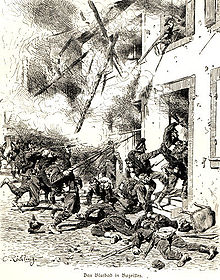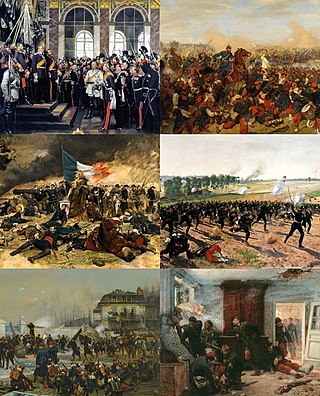
The Franco-Prussian War or Franco-German War, often referred to in France as the War of 1870, was a conflict between the Second French Empire and the North German Confederation led by the Kingdom of Prussia. Lasting from 19 July 1870 to 28 January 1871, the conflict was caused primarily by France's determination to reassert its dominant position in continental Europe, which appeared in question following the decisive Prussian victory over Austria in 1866. According to some historians, Prussian chancellor Otto von Bismarck deliberately provoked the French into declaring war on Prussia in order to induce four independent southern German states—Baden, Württemberg, Bavaria and Hesse-Darmstadt—to join the North German Confederation; other historians contend that Bismarck exploited the circumstances as they unfolded. All agree that Bismarck recognized the potential for new German alliances, given the situation as a whole.
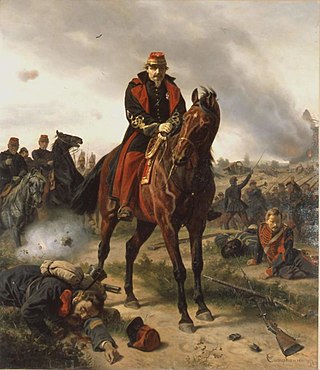
The Battle of Sedan was fought during the Franco-Prussian War from 1 to 2 September 1870. Resulting in the capture of Emperor Napoleon III and over a hundred thousand troops, it effectively decided the war in favour of Prussia and its allies, though fighting continued under a new French government.

The Battle of Abensberg took place on 20 April 1809 between a Franco-German force under the command of Emperor Napoleon I of France and a reinforced Austrian corps led by Feldmarschall-Leutnant Archduke Louis of Austria. As the day wore on, Feldmarschall-Leutnant Johann von Hiller arrived with reinforcements to take command of the three corps that formed the Austrian left wing. The action ended in a complete Franco-German victory. The battlefield was southeast of Abensberg and included clashes at Offenstetten, Biburg-Siegenburg, Rohr in Niederbayern, and Rottenburg an der Laaber. On the same day, the French garrison of Regensburg capitulated.

The siege of Metz was a battle fought during the Franco-Prussian War from August 19 to October 27, 1870 and ended in a decisive allied German victory.

The Battle of Wissembourg or Battle of Weissenburg, the first of the Franco-Prussian War, was joined when three German army corps surprised the small French garrison at Wissembourg on 4 August 1870. The defenders, greatly outnumbered, fought stubbornly "especially considering they were surprised and greatly outnumbered, that the French sustained their old renown as fighting men and that the first defeat, although severe, reflected no discredit on the soldiers of the 1st Corps." The fall of Wissembourg allowed the Prussian army to move into France and compelled Marshal Patrice MacMahon to give battle, and suffer defeat, at the Battle of Wörth on 6 August.

The Troupes de Marine or TDM, sometimes simply referred to as "French Marines" in English, are one of the major components of the French Army and comprise several specialties: infantry, airborne, armoured cavalry, artillery, engineering, and transmissions (signals). Characterized by their fundamental vocation for service beyond the seas, including in French overseas territories and, formerly, in French colonies, the Marines have taken part in all French military campaigns since the corps' foundation, both on home soil and in theaters of operations around the world. They are stationed in Metropolitan France, in many French overseas departments and territories, as well as in Africa.

The Battle of Landshut took place on 21 April 1809 between the French, Württembergers and Bavarians under Napoleon which numbered about 77,000 strong, and 36,000 Austrians under the General Johann von Hiller. The Austrians, though outnumbered, fought hard until Napoleon arrived, when the battle subsequently became a clear French victory.
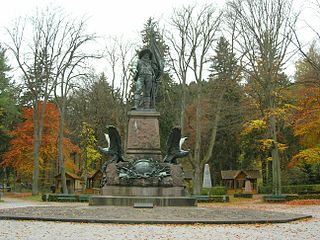
The Battles of Bergisel were four battles fought between Tyrolese civilian militiamen and a contingent of Austrian government troops and the military forces of Emperor Napoleon I of France and King of Kingdom of Bavaria against at the Bergisel hill near Innsbruck. The battles, which occurred on 25 May, 29 May, 13 August, and 1 November 1809, were part of the Tyrolean Rebellion and the War of the Fifth Coalition.
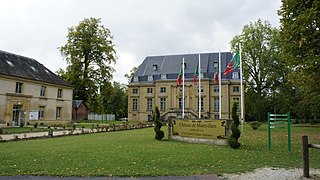
Bazeilles is a commune in the Ardennes department in the Grand Est region of northern France. On 1 January 2017, the former communes of Rubécourt-et-Lamécourt and Villers-Cernay were merged into Bazeilles. On 1 January 2024, the former commune of La Moncelle was merged into Bazeilles.

The 1st Marine Infantry Regiment is a French regiment heir of the colonial infantry. The regiment is one of the quatre vieux regiments of the Troupes de Marine, with the 2nd Marine Infantry Regiment 2e RIMa, the 3rd Marine Infantry Regiment 3e RIMa, as well the 4th Marine Infantry Regiment 4e RIMa. Along with the 1st Marine Artillery Regiment 1er RAMa and the 2nd Marine Artillery Regiment 2e RAMa, the 1st Marine formed the Blue Division. The 1er RIMa is a light armoured unit, since 1986, alike with the régiment d'infanterie-chars de marine RICM.

The Blue Division was a French division during the Franco-Prussian War of 1870. Consisting of Troupes de Marine, it was the first time in the history of the marines to combine marsouins, marine infantry, and bigors, or marine artillery.

The 2nd Marine Infantry Regiment is an infantry regiment of the Troupes de marine in the French Army, the only regiment to bear 16 battle honours inscriptions of the regimental colors. The regiment is one of the "quatre vieux" regiments of the Troupes de marine, with the 1st Marine Infantry Regiment 1er RIMa, the 3rd Marine Infantry Regiment 3e RIMa and the 4th Marine Infantry Regiment 4e RIMa ; also, alongside the 1st Marine Artillery Regiment 1er RAMa as well as the 2nd Marine Artillery Regiment 2e RAMa which formed the Blue Division.
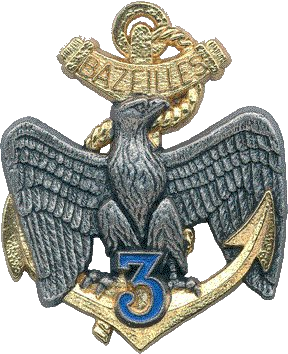
The 3rd Marine Infantry Regiment is a unit of the French Army in the French Forces. The 3e RIMa is one of the oldest of the troupes de marine. This regiment is one of the "Quatre Grands" of marine infantry once garrisoned within the four military ports, ready to embark : the « Grand Un », the « Grand Deux », the « Grand Trois » and the « Grand Quatre ». The « Grand Trois » has participated actively to the various far expeditions of the 19th century in Africa, the Americas, Oceania and the Orient. Surnamed also the "3rd Marine", the unit was part of the « Blue Division » which illustrated capability at the Battle of Bazeilles on August 31 and September 1, 1870. The regiment was subordinated to the 9th Marine Infantry Brigade.

The Battle of Neumarkt-Sankt Veit on 24 April 1809 saw a Franco-Bavarian force led by Marshal Jean-Baptiste Bessières face an Austrian Empire army commanded by Johann von Hiller. Hiller's numerically superior force won a victory over the Allied troops, forcing Bessières to retreat to the west. Neumarkt-Sankt Veit is located ten kilometers north of Mühldorf and 33 kilometers southeast of Landshut in Bavaria.

The Battle of Wörgl or Wörgel was fought on 13 May 1809, when a Bavarian force under French Marshal François Joseph Lefebvre attacked an Austrian Empire detachment commanded by Johann Gabriel Chasteler de Courcelles. The Bavarians severely defeated Chasteler's soldiers in series of actions in the Austrian towns of Wörgl, Söll, and Rattenberg. Wörgl is located 20 kilometres (12 mi) south of the modern-day German border on the upper Inn River.

Bernhard Erasmus von Deroy from the Electorate of the Palatinate became a noted general officer in the army of Bavaria. His military career began shortly after the start of the Seven Years' War. During the French Revolutionary Wars he first served on the side of the Coalition against the French revolutionaries, then fought as an ally of the First French Empire during the Napoleonic Wars. Deroy and his colleague, Karl Philipp von Wrede, were dominant personalities in the Bavarian military during the era of Napoleon Bonaparte.
The Battle of Châtillon, also known as the Battle of Châtillon-sous-Bagneux, was a skirmish in the Siege of Paris between France and North German Confederation in the Franco-Prussian War, took place on 13 October 1870. This is also considered the first battle in the history of the French Third Republic. In this fierce battle – occurred at Châtillon and Sceaux, Corps V of the Prussian army under the command of Lieutenant General Infantry Hugo von Kirchbach, along with the II Corps of the Kingdom of Bavaria by the Supreme Minister infantry Jakob von Hartmann which were the forces of the army Group 3 of Prussia by Prince Friedrich Wilhelm as General command., won a victory against an attack by the XIV Corps under General Renault - of the French army under General Auguste-Alexandre Ducrot. Although some soldiers under Ducrot fought well, the majority of his army became agitated. The French were forced to flee to Paris, losing the Châtillon Plateau - a very favorable defensive position overlooking the fortresses south of Paris - to the Germans. This was a disaster for the "justice" of the French army during the war, although the French reported that they suffered only minor losses.

Arsène Lambert was a senior French general who achieved particular distinction in the French conquest of Senegal and, later, in the Franco-Prussian War of 1870.
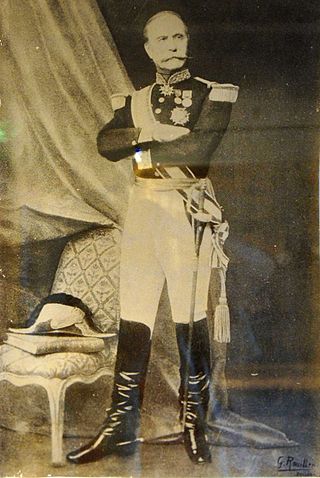
Élie, Jean de Vassoigne was a French general who distinguished himself in the Baltic in 1854 against the Russians in the Battle of Bomarsund, then commanded from 1854 to 1856 the occupation corps of Greece during the Crimean War. Then in 1859 and 1860, he went to campaign in China commanding the 3e régiment de Marine brigade of General Collineau. He was then sent to Tonkin and Annam in Cochinchina from 1860 to 1861. On February 27, 1861, during the Battle of Ky Hoa, he was seriously injured by an arrow. In 1870, he took part in the Battle of Sedan, during the Franco-Prussian War.

The Battle of Varize took place during the Franco-Prussian War on November 29, 1870, in Varize, on the river Conie. In this battle, the First Bavarian Corps under the command of Lieutenant General Infantry Ludwig von der Tann attacked a guerrilla army franc-tireurs of the French Republic under the command of Colonel Ernest de Lipowski, and made them scatter. Despite this, the defense at Varize enabled General Antoine Chanzy, commander of the French Army of Loire, to establish a defensive formation against the Prussian army under the direction of Friedrich Franz II, Grand Duke of Mecklenburg-Schwerin. With their victory at the Battle of Varize, Bavarian forces captured a number of well-equipped French guerrillas.


